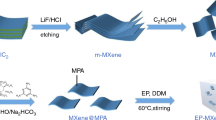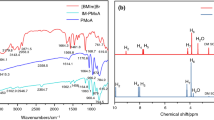Abstract
In this work, we employed a two-step modification process to improve the properties of 2D bimetallic nanoplates M(OH)(OCH3) (M = Co, Ni), which were recently proven as a promising “nano-flame retardant”. The nanoplates were in situ modified with metal-organic framework ZIF-67 first and then silanized with a coupling agent APTES. Epoxy resin (EP) nanocomposites were fabricated using the functionalized M(OH)(OCH3). We investigated the performance of the nanocomposites in flame retardance and thermal stability. The results showed that 3% of APTES@ZIF-67@M(OH)(OCH3) gave the EP nanocomposite the V-1 rating in UL-94 test and the highest limited oxygen index of 27.6%. Moreover, the pHRR value of EP/APTES@ZIF-67@M 3% was reduced by 20.0% and 9.6%, respectively, compared to neat EP and EP/ZIF-67@M 3%. Regarding the mechanical properties, the Tensile properties and energy storage modulus of EP nanocomposite were both improved with 3% of APTES@ZIF-67@M(OH)(OCH3). The GC-MS test results revealed that the functionalized M(OH)(OCH3) significantly increased the cross-linking propensity of the EP matrix upon combustion, leading to the formation of a dense char layer. This study demonstrates the great potential of M(OH)(OCH3) as a highly efficient “nano-flame retardant” with tunable functionality.















Similar content being viewed by others
Data availability
The data are available from the corresponding author upon sensible request.
References
Ma C, Li J (2019) Synthesis of an organophosphorus flame retardant derived from daidzein and its application in epoxy resin. Compos Pt B-Eng 178:11. https://doi.org/10.1016/j.compositesb.2019.107471
Zhang QQ, Yang S, Wang J, Cheng JW, Zhang QX, Ding GP, Hu YF, Huo SQ (2019) A DOPO based reactive flame retardant constructed by multiple heteroaromatic groups and its application on epoxy resin: curing behavior, thermal degradation and flame retardancy. Polym Degrad Stabil 167:10–20. https://doi.org/10.1016/j.polymdegradstab.2019.06.020
Li SC, Chen D, Gao C, Yuan YH, Wang HY, Liu X, Hu BZ, Ma JW, Liu MJ, Wu ZJ (2020) Epoxy-functionalized polysiloxane/Nano-SiO2 synergistic reinforcement in cryogenic mechanical properties of epoxy and carbon fiber reinforced epoxy laminate. Compos Sci Technol 198:11. https://doi.org/10.1016/j.compscitech.2020.108292
Qian ZZ, Xiao YX, Zhang XJ, Li Q, Wang LJ, Fu FY, Diao HY, Liu XD (2022) Bio-based epoxy resins derived from diphenolic acid via amidation showing enhanced performance and unexpected autocatalytic effect on curing. Chem Eng J 435:11. https://doi.org/10.1016/j.cej.2022.135022
Chi H, Lin ZW, Chen YX, Zheng RH, Qiu H, Hu XL, Bai H (2022) Three-dimensional printing and recycling of multifunctional composite material based on commercial epoxy resin and graphene nanoplatelet. ACS Appl Mater Interfaces 14(11):13758–13767. https://doi.org/10.1021/acsami.2c00910
Liu C, Li P, Xu YJ, Liu Y, Zhu P, Wang YZ (2022) Bio-based nickel alginate toward improving fire safety and mechanical properties of epoxy resin. Polym Degrad Stabil 200:12. https://doi.org/10.1016/j.polymdegradstab.2022.109945
Rao WH, Zhao P, Yu CB, Zhao HB, Wang YZ (2021) High strength, low flammability, and smoke suppression for epoxy thermoset enabled by a low-loading phosphorus-nitrogen-silicon compound. Compos Pt B-Eng 211:12. https://doi.org/10.1016/j.compositesb.2021.108640
Zhi MY, Yang X, Fan R, Yue S, Zheng LL, Liu QY, He YH (2022) A comprehensive review of reactive flame-retardant epoxy resin: fundamentals, recent developments, and perspectives. Polym Degrad Stabil 201:33. https://doi.org/10.1016/j.polymdegradstab.2022.109976
Tang W, Qian LJ, Chen YJ, Qiu Y, Xu B, Li J (2020) Joint-aggregation intumescent flame-retardant effect of ammonium polyphosphate and charring agent in polypropylene, Polym. Adv Technol 31(8):1699–1708. https://doi.org/10.1002/pat.4897
Li ZQ, Li W, Liao L, Li JB, Wu T, Ran LC, Zhao TB, Chen BS (2020) Preparation and properties of polybutylene-terephthalate/graphene oxide in situ flame-retardant material. J Appl Polym Sci 137(40):10. https://doi.org/10.1002/app.49214
Chang TH, Tian Y, Wee DLY, Ren HL, Chen PY (2018) Crumpling and unfolding of montmorillonite hybrid nanocoatings as stretchable flame-retardant skin. Small 14(21):9. https://doi.org/10.1002/smll.201800596
Yang XL, Shen AQ, Liang MM, Jiang YX, Meng YJ (2021) Dynamic flame retardancy and flame mechanism of SBS- modified asphalt containing alumina trihydrate and organic montmorillonite. Constr Build Mater 309:12. https://doi.org/10.1016/j.conbuildmat.2021.125077
Ma WL, Liu XY, Qiu ZR, Cai ZH, Diao JL, Huang Y (2022) Hydrophobic and flame-retardant multifunctional foam for enhanced thermal insulation and broadband microwave absorption via a triple-continuous network of RGO/MWCNT-melamine composite. Carbon 196:913–922. https://doi.org/10.1016/j.carbon.2022.05.060
Li ZQ, Li JB, Chen YL, Ye JBA, Song XQ, Jin Y, Wu T, Chen BS (2022) Flame retardant and mechanical properties of core-shell-like polybutylene terephthalate/intumescent flame retardant through controlling injection time, Polym. Adv Technol 33(4):1317–1327. https://doi.org/10.1002/pat.5605
Yang Q, Jia YX, Zhou XM, Zhang HJ (2022) Mechanically reinforced flame-retardant epoxy resins by layered double hydroxide in situ decorated carbon nanotubes. ACS Appl Polym Mater 4(9):6731–6741. https://doi.org/10.1021/acsapm.2c01110
Yu B, Xing WY, Guo WW, Qiu SL, Wang X, Lo SM, Hu Y (2016) Thermal exfoliation of hexagonal boron nitride for effective enhancements on thermal stability, flame retardancy and smoke suppression of epoxy resin nanocomposites via sol-gel process. J Mater Chem A 4(19):7330–7340. https://doi.org/10.1039/c6ta01565d
Wang SG, Yu B, Zhou KQ, Yin L, Zhong Y, Ma X (2019) A novel phosphorus-containing MoS2 hybrid: towards improving the fire safety of epoxy resin. J Colloid Interface Sci 550:210–219. https://doi.org/10.1016/j.jcis.2019.05.003
Dong X, Ma Y, Fan XG, Zhao S, Xu YX, Liu S, Jin D (2021) Nickel modified two-dimensional bimetallic nanosheets, M (OH)(OCH3) (M = co, ni), for improving fire retardancy and smoke suppression of epoxy resin. Polymer 235:13. https://doi.org/10.1016/j.polymer.2021.124263
Song XN, Hou BY, Han ZD, Pan YT, Geng ZS, Ibarra LH, Yang RJ (2023) Dual nucleation sites induced by ZIF-67towards mismatch of polyphosphazene hollow sub-micron polyhedrons and nanospheres in flame retardant epoxy matrix. Chem Eng J. https://doi.org/10.1016/j.cej.2023.144278
Liu XL, Verma G, Chen ZS, Hu BW, Huang QF, Yang H, Ma SQ, Wang XK (2022) Metal-organic framework nanocrystal-derived hollow porous materials: synthetic strategies and emerging applications. Innov (Camb) 3:5. https://doi.org/10.1016/j.xinn.2022.100281
Xu WZ, Wang XL, Wu Y, Li W, Chen CY (2019) Functionalized graphene with Co-ZIF adsorbed borate ions as an effective flame retardant and smoke suppression agent for epoxy resin. J Hazard Mater 363:138–151. https://doi.org/10.1016/j.jhazmat.2018.09.086
Zhu KK, Hua WM, Wang XY (2011) A facile synthesis of NiO nanosheet with high-energy (111) surface. Chem Lett 40(2):156–158. https://doi.org/10.1246/cl.2011.156
Li WH, Lin ZY, Zuo HY, Zhong JH, Xu YT, Zeng BR, Luo WA, Chen GR, Yuan CH, Dai LZ (2022) ZIF-8@Co-doped boronate ester polymer core-shell particles: catalytically enhancing the nonflammability and smoke suppression of epoxy resin. Polym Degrad Stabil 198:11. https://doi.org/10.1016/j.polymdegradstab.2022.109877
Yang J, Zhang A, Chen YX, Wang LS, Li MX, Yang HY, Hou YB (2022) Surface modification of core-shell structured ZIF-67@Cobalt coordination compound to improve the fire safety of biomass aerogel insulation materials. Chem Eng J 430:12. https://doi.org/10.1016/j.cej.2021.132809
Zhou YF, Qiu SL, Chu FK, Yang WH, Qiu Y, Qian LJ, Hu WZ, Song L (2022) High-performance flexible polyurethane foam based on hierarchical BN@MOF-LDH@APTES structure: enhanced adsorption, mechanical and fire safety properties. J Colloid Interface Sci 609:794–806. https://doi.org/10.1016/j.jcis.2021.11.089
Fu C, Xu XL, Yin GZ, Xu BY, Li PY, Ai B, Zhai ZJ, Gao F, Zhai JG, Wang DY (2022) Surface engineering for cellulose as a boosted layer-by-layer assembly: excellent flame retardancy and improved durability with introduction of bio-based molecular glue. Appl Surf Sci 585:12. https://doi.org/10.1016/j.apsusc.2022.152550
Liu DY, Cui YH, Zhang TL, Zhao WH, Ji PF (2021) Improving the flame retardancy and smoke suppression of epoxy resins by introducing of DOPO derivative functionalized ZIF-8. Polym Degrad Stab 194:13. https://doi.org/10.1016/j.polymdegradstab.2021.109749
Li ZF, Zhang CJ, Cui L, Zhu P, Yan C, Liu Y (2017) Fire retardant and thermal degradation properties of cotton fabrics based on APTES and sodium phytate through layer-by-layer assembly. J Anal Appl Pyrolysis 123:216–223. https://doi.org/10.1016/j.jaap.2016.11.026
Wang WK, Zhang HM, Zhang SB, Liu YY, Wang GZ, Sun CH, Zhao HJ (2019) Potassium ion assisted regeneration of active cyano groups in carbon nitride aanoribbons: visible light driven photocatalytic nitrogen reduction. Angew Chem -Int Edit 58(46):16644–16650. https://doi.org/10.1002/anie.201908640
Hursan D, Samu AA, Janovak L, Artyushkova K, Asset T, Atanassov P, Janaky C (2019) Morphological attributes govern carbon dioxide reduction on N-doped carbon electrodes. Joule 3(7):1719–1733. https://doi.org/10.1016/j.joule.2019.05.007
Liu N, Wang H, Xu BS, Qu LJ, Fang DN (2022) Cross-linkable phosphorus/nitrogen-containing aromatic ethylenediamine endowing epoxy resin with excellent flame retardancy and mechanical properties. Compos Pt A-Appl Sci Manuf 162:12. https://doi.org/10.1016/j.compositesa.2022.107145
Zhou YF, Chu FK, Yang WH, Qiu SL, Hu Y (2022) MOF-derived strategy to obtain CuCoOx functionalized HO-BN: a novel design to enhance the toughness, fire safety and heat resistance of bismaleimide resin. Chem Eng J 431:11. https://doi.org/10.1016/j.cej.2021.134013
Sui YL, Sima HF, Shao WD, Zhang CL (2022) Novel bioderived cross-linked polyphosphazene microspheres decorated with FeCo-layered double hydroxide as an all-in-one intumescent flame retardant for epoxy resin. Compos Pt B-Eng 229:12. https://doi.org/10.1016/j.compositesb.2021.109463
Xu Y, Yang WJ, Zhou QK, Gao TK, Xu GM, Tai QL, Zhu SE, Lu HD, Yuen RKK, Yang W, Wei CX (2022) Highly thermo-stable resveratrol-based flame retardant for enhancing mechanical and fire safety properties of epoxy resins. Chem Eng J 450:13. https://doi.org/10.1016/j.cej.2022.138475
Jiang GY, Xiao XL, Qian ZY, Yang YT, Jia PF, Song L, Hu Y, Ma C, Gui Z (2023) A novel phosphorus-, nitrogen- and sulfur-containing macromolecule flame retardant for constructing high-performance epoxy resin composites. Chem Eng J 451:12. https://doi.org/10.1016/j.cej.2022.137823
Lian RC, Guan HC, Zhang YQ, Ou MY, Jiang YP, Liu L, Jiao CM, Chen XL (2023) A green organic-inorganic PAbz@ZIF hybrid towards efficient flame-retardant and smoke-suppressive epoxy coatings with enhanced mechanical properties. Polym Degrad Stab 217. https://doi.org/10.1016/j.polymdegradstab.2023.110534
Sun Q, Wang JL, Meng X, Zhang J, Yan H (2023) A novel high-efficient P/N/Si-containing APP-based flame retardant with a silane coupling agent in its molecular structure for epoxy resin. Chin J Chem Eng 55:137–147. https://doi.org/10.1016/j.cjche.2022.06.004
Lin HJ, Yan H, Liu B, Wei LQ, Xu BS (2011) The influence of KH-550 on properties of ammonium polyphosphate and polypropylene flame retardant composites. Polym Degrad Stab 96:1382–1388. https://doi.org/10.1016/j.polymdegradstab.2011.03.016
Liu CJ, Tao J, Wu T, Zhao HB, Yu CB, Rao WH (2023) Construction of hierarchical SiO2microcapsule towards flame retardation, low toxicity and mechanical enhancement of epoxy resins. Chemosphere 342. https://doi.org/10.1016/j.chemosphere.2023.140184
Acknowledgements
This work was financially supported by the Natural Science Research Project of Universities in Anhui Province (KJ2020A0326); Anhui Province Natural Science Foundation (2008085QE269).
Funding
Natural Science Research Project of Universities in Anhui Province, KJ2020A0326, Xiang Dong, Anhui Province Natural Science Foundation, 2008085QE269, Xiang Dong
Author information
Authors and Affiliations
Corresponding author
Ethics declarations
Conflict of interest
Authors exhibit no conflict of interest.
Additional information
Publisher’s Note
Springer Nature remains neutral with regard to jurisdictional claims in published maps and institutional affiliations.
Rights and permissions
Springer Nature or its licensor (e.g. a society or other partner) holds exclusive rights to this article under a publishing agreement with the author(s) or other rightsholder(s); author self-archiving of the accepted manuscript version of this article is solely governed by the terms of such publishing agreement and applicable law.
About this article
Cite this article
Dong, X., Li, Dl., Xie, L. et al. APTES modification of ZIF-67@M(OH)(OCH3) for enhanced flame retardancy and mechanical properties of epoxy resins. J Polym Res 31, 40 (2024). https://doi.org/10.1007/s10965-024-03879-8
Received:
Accepted:
Published:
DOI: https://doi.org/10.1007/s10965-024-03879-8




